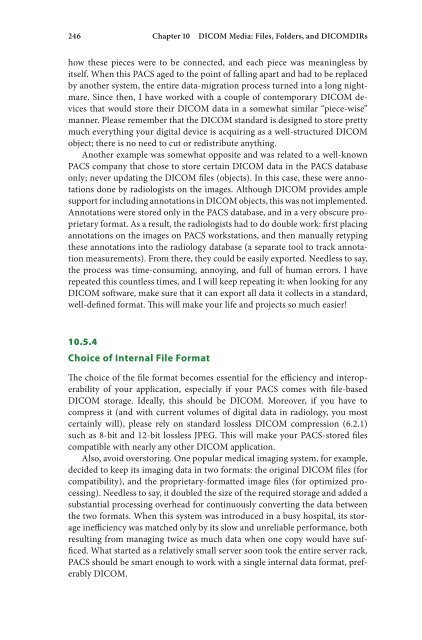Digital Imaging and Communications in Medicine (DICOM)
Digital Imaging and Communications in Medicine (DICOM)
Digital Imaging and Communications in Medicine (DICOM)
Create successful ePaper yourself
Turn your PDF publications into a flip-book with our unique Google optimized e-Paper software.
246<br />
Chapter 10 <strong>DICOM</strong> Media: Files, Folders, <strong>and</strong> <strong>DICOM</strong>DIRs<br />
how these pieces were to be connected, <strong>and</strong> each piece was mean<strong>in</strong>gless by<br />
itself. When this PACS aged to the po<strong>in</strong>t of fall<strong>in</strong>g apart <strong>and</strong> had to be replaced<br />
by another system, the entire data-migration process turned <strong>in</strong>to a long nightmare.<br />
S<strong>in</strong>ce then, I have worked with a couple of contemporary <strong>DICOM</strong> devices<br />
that would store their <strong>DICOM</strong> data <strong>in</strong> a somewhat similar “piece-wise”<br />
manner. Please remember that the <strong>DICOM</strong> st<strong>and</strong>ard is designed to store pretty<br />
much everyth<strong>in</strong>g your digital device is acquir<strong>in</strong>g as a well-structured <strong>DICOM</strong><br />
object; there is no need to cut or redistribute anyth<strong>in</strong>g.<br />
Another example was somewhat opposite <strong>and</strong> was related to a well-known<br />
PACS company that chose to store certa<strong>in</strong> <strong>DICOM</strong> data <strong>in</strong> the PACS database<br />
only; never updat<strong>in</strong>g the <strong>DICOM</strong> files (objects). In this case, these were annotations<br />
done by radiologists on the images. Although <strong>DICOM</strong> provides ample<br />
support for <strong>in</strong>clud<strong>in</strong>g annotations <strong>in</strong> <strong>DICOM</strong> objects, this was not implemented.<br />
Annotations were stored only <strong>in</strong> the PACS database, <strong>and</strong> <strong>in</strong> a very obscure proprietary<br />
format. As a result, the radiologists had to do double work: first plac<strong>in</strong>g<br />
annotations on the images on PACS workstations, <strong>and</strong> then manually retyp<strong>in</strong>g<br />
these annotations <strong>in</strong>to the radiology database (a separate tool to track annotation<br />
measurements). From there, they could be easily exported. Needless to say,<br />
the process was time-consum<strong>in</strong>g, annoy<strong>in</strong>g, <strong>and</strong> full of human errors. I have<br />
repeated this countless times, <strong>and</strong> I will keep repeat<strong>in</strong>g it: when look<strong>in</strong>g for any<br />
<strong>DICOM</strong> software, make sure that it can export all data it collects <strong>in</strong> a st<strong>and</strong>ard,<br />
well-def<strong>in</strong>ed format. This will make your life <strong>and</strong> projects so much easier!<br />
10.5.4<br />
Choice of Internal File Format<br />
The choice of the file format becomes essential for the efficiency <strong>and</strong> <strong>in</strong>teroperability<br />
of your application, especially if your PACS comes with file-based<br />
<strong>DICOM</strong> storage. Ideally, this should be <strong>DICOM</strong>. Moreover, if you have to<br />
compress it (<strong>and</strong> with current volumes of digital data <strong>in</strong> radiology, you most<br />
certa<strong>in</strong>ly will), please rely on st<strong>and</strong>ard lossless <strong>DICOM</strong> compression (6.2.1)<br />
such as 8-bit <strong>and</strong> 12-bit lossless JPEG. This will make your PACS-stored files<br />
compatible with nearly any other <strong>DICOM</strong> application.<br />
Also, avoid overstor<strong>in</strong>g. One popular medical imag<strong>in</strong>g system, for ex ample,<br />
decided to keep its imag<strong>in</strong>g data <strong>in</strong> two formats: the orig<strong>in</strong>al <strong>DICOM</strong> files (for<br />
compatibility), <strong>and</strong> the proprietary-formatted image files (for optimized process<strong>in</strong>g).<br />
Need less to say, it doubled the size of the required storage <strong>and</strong> added a<br />
substantial process<strong>in</strong>g overhead for cont<strong>in</strong>uously convert<strong>in</strong>g the data between<br />
the two formats. When this system was <strong>in</strong>troduced <strong>in</strong> a busy hospital, its storage<br />
<strong>in</strong>efficiency was matched only by its slow <strong>and</strong> unreliable performance, both<br />
result<strong>in</strong>g from manag<strong>in</strong>g twice as much data when one copy would have sufficed.<br />
What started as a relatively small server soon took the entire server rack.<br />
PACS should be smart enough to work with a s<strong>in</strong>gle <strong>in</strong>ternal data format, preferably<br />
<strong>DICOM</strong>.











